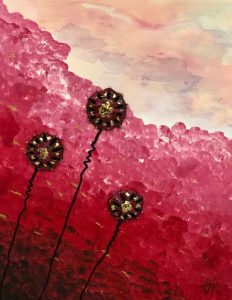How to Get Artistically Motivated
Category : Arts
 In writing, we call it ‘writer’s block’ and the same thing can happen for an artist. You’re just not feeling inspired to work or create. Sometimes it’s a lack of ‘what next’ once you finish a project. There are many ways to get inspiration.
In writing, we call it ‘writer’s block’ and the same thing can happen for an artist. You’re just not feeling inspired to work or create. Sometimes it’s a lack of ‘what next’ once you finish a project. There are many ways to get inspiration.
Let’s have a look at how to get artistically motivated
Know your purpose
The first thing is to know why you are creating. For the ease of this article, let’s use the term painting, but when I say painting, it might be sculpture, pottery, watercolours, mosaic, or any number of other artistic mediums. If you are painting because you have a show or exhibit on and there is a deadline, that is entirely different from painting for pleasure and enjoyment. If the purpose is essentially a business or a deadline, then you need to implement more business-like actions. In business, even if you are working from home and have a degree of flexibility, you still need to work every day (or almost every day). You need to get up in the morning, get dressed for work (I don’t prescribe that productivity occurs in our pyjamas) and ‘work’ a reasonably set number of hours. You should take breaks at regular intervals, just like in a job, not too few and not every 10 minutes. You should stay focussed, so the TV stays off and you turn off the Facebook notifications.
Have a work station or studio
In a perfect world, you have a studio. It’s got everything in there, all set up and ready for action. However in reality you may be using a shared space or room that doubles up as a dining room or office or garage. If you don’t have a defined room and need to set up at the beginning of each session, then I strongly recommend you have a cupboard or table or set of drawers that has all your ‘stuff’. Living out of a box or out of a pile in another room is disruptive. If you are sharing a room, try to snag a cupboard or desk space (with deep drawers) that you can store your items. You might not fit everything in there, but hopefully, the basics are there.
Set up your equipment and tools
I come from a few artists; my great grandfather was John Somers Snr and I remember my father telling me how important it was to clean my brushes after every use. Absolutely true! After every use, I clean the brushes thoroughly, wipe down surfaces, sharpen pens and put everything back neatly. This means that when I start next time, there is none of the chore of prep to start. It psychologically makes starting a far more pleasant task – I can just jump in.
How to get inspiration
So, you’re setup, you have all your gears in place, you have a work area and you’re ready for action. What’s missing? Maybe it’s an idea or an inspiration? Depending on what your subject is, or your style, you may have a range of options to find inspiration. For myself, I use a few methods.
One thing which inspires me is nature. If I’m walking along the beach I might see something interesting or beautiful. The same goes for walking in the bush, or my garden or simply an animal I see out on the patio. Where possible I will take a photo. I can capture that idea instantly and then convert it to a drawing.
Another way to get inspired is to Google images. Now I’m in no way saying copy others, but sometimes in looking at pictures, photos, scenes, you may see an inspiring colour or a scene which captures your heart. Sometimes the ideas are as simple as a shape or a colour combination. I screenshot that image and keep it.
Now you have all these images and thoughts but what do you do with them? I personally use two methods. The first is a sketch pad of ideas and I just keep that one pad full of ideas and regularly flick through it. The other thing that I have is a digital folder of ideas which I label and keep for consideration as well.
Setting the scene
For me, the final step of getting motivated to work, once I have ideas and a workspace, is to set the scene. It’s a little like the setup for a romantic evening – perhaps we’ll call this ‘artistic romance’. I put on music, perhaps even light some scented candles and block out space so I’m not feeling rushed. Yes, I may often ignore my phone (especially social media which seems to be incessant) and simply have ‘time out’ for me to work and spend time with my piece. I will have already eaten (so stomach rumbling isn’t a distraction) and for sure the TV is off.
If you are running a business or have a deadline for production or an exhibition, then you cannot be so relaxed about the time you take to do it. You cannot simply get artistic “when I feel like it” but will need to set a time to work. To be productive you need to move from a hobby type mentality of doing it when you ‘have spare time’. Gosh, who has that! Instead, make time. I know when I began writing my first book the first quarter took 2.5 years. Thereafter (once I shifted my mind space from hobby to business) I was able to write a book in 2 to 6 months. In all, I wrote six books because I was thinking of business and not thinking of hobby. I never have ‘spare time’ but I can find the time and make time. This circles back to your purpose. If you have no deadlines, then you paint when you’re inspired and it might be months between sittings and if you are ok with that – then that is perfectly fine.
Have fun and enjoy! Check out my artworks for sale.
